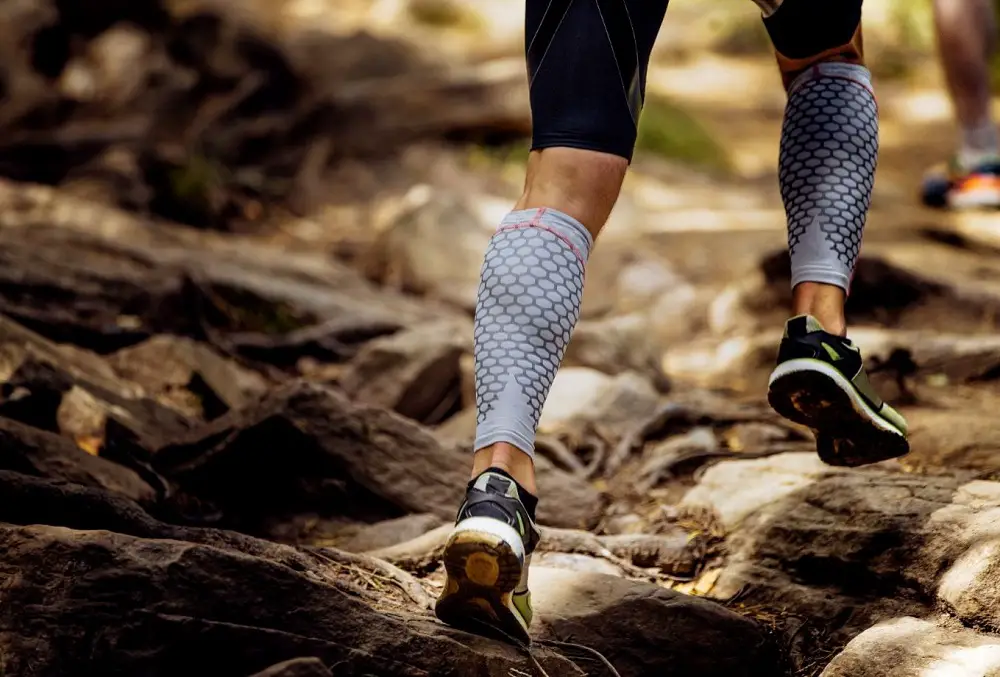Whether watching a pro athlete in a game or spotting a casual jogger on the street, everyone seems to be wearing compression sleeves these days. But are they actually doing anything? Or is it just a passing fad? Read on to find out what compression sleeves actually are and if you should invest in some to improve your sports performance.

What Are Compression Sleeves?
Often made from a nylon/spandex fabric blend, compression sleeves fit tightly around your arms or legs and come in many shapes and sizes, ranging from socks to leggings to full-on bodysuits.
How Do They Work?
Compression sleeves work by manipulating your veins and arteries to improve and increase blood flow to certain areas of your body, while also improving circulation.
Compression is measured in millimeters of mercury (mmHg), which is the amount of pressure that the sleeve can exert on your arm or leg. Supposedly in order for a compression sock to work effectively, it must have a minimum of 20mmHg at the ankle.
To understand how compression works, it helps to have a basic understanding of how blood flows through the body and how this has an impact on exercising.
The heart pumps oxygen-filled blood to muscles through arteries, and once it’s been delivered to where it needs to go the deoxygenated blood, along with waste products like lactic acid, is pumped back to the heart to repeat this process again.
The amount of oxygenated blood flowing through your muscles is important when keeping your performance up while exercising.
The more oxygen your muscles have the better they will function. Also if the waste lactic acid is not removed from the muscle fast enough this can lead to soreness and a decreased ability to perform well.
This is where compression sleeves come in. They essentially help fight against gravity and push your blood towards your heart to prevent it from “pooling” or collecting in areas like your thighs.
They can also supposedly slow down the effects of muscle fatigue that can occur due to the shock and vibration that goes through your legs while running.
Should I Wear Compression Sleeves while Running?
Despite many athletes choosing to wear compression sleeves while running, there’s actually little evidence to prove that they improve performance. Several studies have been conducted over the years to try and prove the effectiveness of compression sleeves, though most have focused on using them post-workout.
Using compression sleeves while running is really down to your own personal preference. Some athletes swear by them saying it helps them run for longer and makes them less sore afterward, while others say that they provide little or no difference to their running experience.
This is something that you need to try to see if it will work for you as it seems that there’s no universal answer as to whether they’re beneficial while running
When Should I Wear Them?
Other sports
While there isn’t much evidence that compression sleeves help while running, there has been proof that they’re useful if you take part in other sports like cycling. Wearing them during cycling seems to lead to an increased concentration of oxygen in the muscles, and lets cycles perform better for longer periods.
During recovery or injury
It is during cool-down periods or recovering from an injury that compression sleeves really shine. They can reduce swelling and soreness in the lower body after exercise, especially in the foot, ankle, and lower leg.
By pushing the blood around your body more effectively, compression sleeves help to flush out all the waste products from your muscles, recirculating them back to your heart. This ensures the waste products like lactic acid don’t sit in your muscles overnight, helping you to recover faster.
With helping with injuries, compression sleeves increase the blood flow to the affected area, aiding in and perhaps even speeding up recovery. They can also prevent the injury from getting worse as well as stop new injuries from occurring.
However, although they’re useful for shin splints, calf cramps, and Achilles tendonitis, it’s vital that you get your injuries examined by a professional and don’t just rely on compression to aid in recovery. While there is proof that they do work in this aspect you should still seek medical advice to find the real source of the issue.
During travel
Due to them improving blood circulation, wearing a compression sleeve can be very beneficial while traveling or if you’ll be sat down for a long time. There is a risk of deep vein thrombosis when you use air travel, which is where a blood clot can form due to a lack of movement for a long time.
This risk is heightened for those with a slower resting blood flow. Wearing a compression sleeve on the legs can lower this risk and help you feel less sore after a long day’s travel.
What Are the Overall Benefits?
- Reduces the amount of lactic acid produced by the muscles – this is produced when the muscles have consumed all the available oxygen in the blood and can cause pain and soreness. By improving oxygen flow you’ll be able to exercise for longer without this happening.
- Reduced swelling and pain
- Leg support slows muscle fatigue as it minimizes the vibrations and shock from running
- Can aid in injury recovering and general cool-down after a workout
Are There Any Risks?
The only real risk is if the sleeve is so tight it cuts off circulation to your leg. Sleeves come in many different shapes and sizes and all offer different amounts of compression so you may have to try a few to see what works for you.
However, wearing the sleeves should never be painful. If it is you’re wearing one that’s too tight and you should take it off or you could cut off your circulation.

